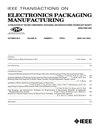Thermomechanical Reliability of Nickel Pillar Interconnections Replacing Flip-Chip Solder Without Underfill
IEEE Transactions on Electronics Packaging Manufacturing
Pub Date : 2008-10-03
DOI:10.1109/TEPM.2008.2001974
引用次数: 6
Abstract
Interconnect technologies between ICs and packages or boards have a significant impact on the IC performance and packaging density. Today, the interconnections are typically accomplished with either wire bonding or flip-chip solders. While both of these technologies are incremental, they also run into either electrical or mechanical barriers as they are extended to higher density of interconnections. Downscaling traditional solder bump interconnect might not satisfy the thermomechanical reliability requirements at very fine-pitches. Alternate interconnection approaches such as compliant interconnects typically require lengthy connections and are therefore limited in terms of electrical properties, although expected to meet the mechanical requirements. This paper reports fine-pitch interconnection technologies using nano-structured nickel as primary interconnection material. The nano-grained nickels are produced by electroplating process. The primary nano-structured interconnects are assembled with different bonding methods to provide organic compatible low-temperature fabrication. Au-Sn and Sn-Cu are used for solder-based assembly of nano-nickel interconnections. Low modulus anisotropic conductive films (ACFs) are also used as an alternate bonding route of the solders. No underfilling is used in all the interconnect structures evaluated in this paper. Assembly are accomplished on different coefficient of thermal expansion (CTE) substrates including FR-4 with 18 ppm/degC, advanced organic substrates with 10 ppm/degC, novel low CTE (3 ppm/degC) substrates based on carbon-silicon carbide (C-SiC). The thermomechanical reliability of all the nano-interconnects assembled on different CTE substrates with different bonding approaches is evaluated by thermal shock testing and finite-element analysis. Nano-nickel interconnects bonded with the ACF showed the highest reliability withstanding 1500 cycles. In all cases, no apparent failure was observed in the primary nano-nickel metal interconnects. This technology is expected to be easily downscaled to submicrometer and nano-scale unlike the current solder technologies leading to true nano-interconnections.镍柱互连代替倒装焊料的热机械可靠性
集成电路与封装或电路板之间的互连技术对集成电路的性能和封装密度有重要影响。今天,互连通常是通过导线键合或倒装芯片焊料完成的。虽然这两种技术都是渐进式的,但当它们扩展到更高密度的互连时,它们也会遇到电气或机械障碍。缩小传统的凸点互连可能无法满足非常细间距的热机械可靠性要求。替代互连方法,如兼容互连通常需要长时间的连接,因此在电气性能方面受到限制,尽管有望满足机械要求。本文报道了以纳米结构镍为主要互连材料的细间距互连技术。采用电镀工艺制备纳米镍。采用不同的键合方法组装初级纳米结构互连,以提供有机兼容的低温制造。Au-Sn和Sn-Cu用于纳米镍互连的焊料基组装。低模量各向异性导电膜(ACFs)也被用作焊料的替代键合路径。本文评价的所有互连结构均未采用下填。组装在不同的热膨胀系数(CTE)衬底上完成,包括FR-4 (18 ppm/degC),高级有机衬底(10 ppm/degC),基于碳-碳化硅(C-SiC)的新型低CTE (3 ppm/degC)衬底。通过热冲击试验和有限元分析,对采用不同连接方式组装在不同CTE衬底上的纳米互连的热力学可靠性进行了评价。与ACF结合的纳米镍互连具有最高的可靠性,可承受1500次循环。在所有情况下,在初级纳米镍金属互连中没有观察到明显的失效。该技术有望轻松缩小到亚微米和纳米级,不像目前的焊料技术导致真正的纳米互连。
本文章由计算机程序翻译,如有差异,请以英文原文为准。
求助全文
约1分钟内获得全文
求助全文

 求助内容:
求助内容: 应助结果提醒方式:
应助结果提醒方式:


